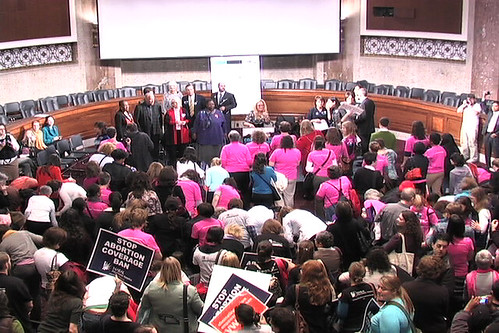Reprinting WND Columns:
If you would like to reprint one of my columns, please request permission from WorldNetDaily.com, which owns the copyright, at reprintpermissions@worldnetdaily.com.
So people have to ask her permission to use her copyrighted material, but she is free to use others'?
We wrote to Jill Stanek, quoted her contact page, and asked her to remove our photos. She replied:
Dear Will,
Thank you for writing.
Please note first of all that I provided attribution and a link to your photos.
I have removed the first photo, per your request.
I am leaving the second photo of Congressperson Jan Schakowsky in place. In legal terms, this photo is “fair use” of a public figure at a public event for purposes of social commentary, which my post certainly makes.
Let me know if you have any further questions.
Thanks,
Jill Stanek
First off, she is right that she attributed the photo to us, and we do appreciate being given the credit. As for her removing the first photo, we are thankful that she did without any fight.
As for the second photo. Here, Jill is dead wrong. Yes, you have the right to publish photos of public figures. You do not have the right to publish another individual's copyrighted photo of a public figure. And I have precedent to make that statement. We have requested precedent to the contrary and await Jill Stanek's reply.
But what about the substance of her post? Our pictures were used to make the argument that the crowd was small.
Sum of Change Productions posted pictures on Flickr (bottom photo via SoC), and you'll notice there are no photos of the crowd.
And yes, we did not post photos of the entire crowd. This was the only lens I had for my camera that day. Not exactly capable of taking a nice wide crowd shot in a packed room. But here is the widest shot we were able to get with our video camera:

The room goes farther back, this shot is from up in the press box. The room was packed, and the overflow room was, at one point, overflowing. It is simply a non-sequitur to argue that because we did not post a shot of the entire crowd that the crowd must have been small.
How about we use that same logic, against, say, the St Michael Society, who "infiltrated" this open-to-the-public event? They are openly anti-choice. They did not post a single shot of the entire crowd. By Jill's logic, they must be hiding how large the crowd was!
Jill's whole point of the article was that the pro-choice rally and lobby day had a small turnout. What Jill misses, is that this was a lobby day, and the indoor rally was truly the secondary objective. The Coalition to Stop Stupak had meetings scheduled in advance between Senators and the activists that attended the rally. That requires a lot of planning, and pulling it off for almost one thousand people from across the country is an enormous feat.
This may not have been a 9/12 rally with hundreds of thousands of people, but then again, it did not get billions of dollars of free advertising from a major, national news network.




